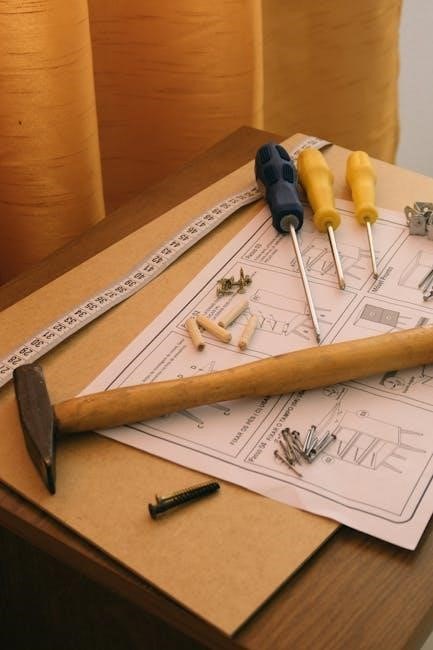This guide provides essential insights into screws, their types, and applications. It covers selection, installation, and troubleshooting, ensuring efficient project completion across various industries and DIY tasks.
Understanding the Importance of Screws in Various Applications
Screws are fundamental in construction, manufacturing, and DIY projects, ensuring structural integrity and durability. Their versatility across materials like wood, metal, and drywall makes them indispensable. From machinery assembly to furniture making, screws provide secure connections. Proper selection and installation are crucial for preventing damage and ensuring longevity. Understanding screw applications helps optimize projects, whether in industrial settings or home improvements, making them a cornerstone of modern engineering and crafting.

Types of Screws
Screws come in various types, each designed for specific applications. Common varieties include machine screws, wood screws, self-tapping screws, drywall screws, and deck screws. Each serves unique purposes.
Machine Screws
Machine screws are designed for securing materials with pre-tapped holes or used alongside nuts. They feature precise threading for strength and are commonly made from stainless steel or zinc-plated steel for durability. Ideal for machinery, automotive, and construction applications, machine screws come in various diameters and lengths to suit specific needs. Their versatility and reliability make them a fundamental component in both industrial and DIY projects.
Wood Screws
Wood screws are specifically designed for securing wood and wood-based materials. They feature a coarse thread pattern to ensure strong grip in wooden surfaces. Available in various lengths and head types, such as flat-head or round-head, wood screws are ideal for furniture assembly, decking, and woodworking projects. They are often made from durable materials like galvanized steel or brass to resist corrosion, making them suitable for both indoor and outdoor applications.
Self-Tapping Screws
Self-tapping screws are designed to create their own threads when driven into materials like metal, plastic, or drywall. They eliminate the need for pre-drilling in soft materials and are commonly used in applications where a strong, permanent hold is required. Available in thread-forming and thread-cutting types, self-tapping screws are versatile and ideal for materials that can be tapped without excessive force, saving time and effort in installation processes.
Drywall Screws
Drywall screws are specifically designed for securing drywall sheets to wooden or metal studs; They feature sharp, coarse threads for strong grip and bugle-shaped heads to prevent tearing the paper layer. Available in varying lengths, they are ideal for both standard and fire-rated drywall. Coated with protective layers, they resist corrosion. Fine-thread screws are used for metal studs, while coarse-thread versions are better for wood, ensuring secure fastening without material damage during installation.
Deck Screws
Deck screws are designed for outdoor use, ensuring durability in harsh weather conditions. Made from stainless steel or coated steel, they resist corrosion and withstand moisture. Available in various lengths, they securely fasten decking boards to joists. Many feature aggressive threads for a strong hold and coatings like zinc or epoxy for added protection; Some deck screws have unique drive systems to prevent stripping, making them ideal for pressure-treated wood, composite, or hardwood decking, ensuring long-lasting stability and safety.

Screwdriver Tools and Accessories
Screwdriver tools and accessories are essential for efficient screw driving. Manual screwdrivers offer precision, while power screwdrivers provide speed. Screwdriver bits and adapters ensure compatibility and versatility.
Manual Screwdrivers
Manual screwdrivers are indispensable tools for precision tasks. They offer excellent control and are ideal for delicate work. Ergonomic handles reduce fatigue, while interchangeable bits accommodate various screw types. Their portability and simplicity make them a must-have for any toolkit, ensuring reliability in both professional and DIY projects.
Power Screwdrivers
Power screwdrivers are advanced tools designed for efficiency and speed. They feature variable torque settings, adjustable RPM, and ergonomic designs to reduce fatigue. Ideal for heavy-duty tasks, they often include rechargeable batteries and LED lights for improved visibility. These tools are essential for industries like construction and automotive, offering precision and power for demanding projects. Their versatility makes them a valuable addition to any professional or DIY toolkit.
Screwdriver Bits and Adapters
Screwdriver bits and adapters are essential for enhancing tool versatility. Bits come in various types, such as Phillips, flathead, and Torx, catering to different screw designs. Adapters allow compatibility with power tools, enabling efficient screwdriving. They reduce the need for multiple tools, saving space and cost. Proper selection ensures secure fits, preventing slippage and damage. Regular maintenance, like cleaning and storing bits, prolongs their lifespan, ensuring reliable performance for both professional and DIY projects.
Measuring and Selecting the Right Screw
Accurate measurement ensures proper screw selection. Diameter, thread pitch, and length are critical. Use tools to verify dimensions for a perfect fit and optimal performance in projects.
Diameter and Thread Pitch
Diameter and thread pitch are critical for screw selection. Measure using calipers or screw gauges for precision. Thread pitch determines compatibility and strength, ensuring proper material engagement. Misaligned pitches can cause instability. Always verify measurements to avoid costly errors and ensure secure, durable connections.
Screw Length and Head Type
Screw length is measured from the tip to the base of the head. Proper length ensures adequate hold without over-sinking. Head types, such as flat, round, or hex, determine functionality. Flat heads are flush, while round heads sit above the surface. Hex heads provide high torque resistance. Matching screw length and head type to the material and application is crucial for optimal performance and stability.
Torque and Loctite Requirements
Torque specifies the rotational force needed to tighten screws, preventing under- or over-tightening. Loctite ensures screws remain secure, especially in vibrating environments. Proper torque application avoids stripped threads, while Loctite adds an extra layer of stability. Always consult torque charts and material guidelines to determine the right torque and Loctite for your project, ensuring long-lasting and reliable fastening solutions.

Drilling and Screw Installation Guide
Proper drilling and installation techniques ensure secure fastening. Pre-drill holes to prevent material splitting. Use pilot bits for accuracy. Maintain steady control during insertion to avoid damage.
Pre-Drilling Holes
Pre-drilling holes is a critical step to ensure smooth screw installation. Use a drill bit slightly smaller than the screw diameter to prevent material splitting. Align the bit carefully to maintain accuracy. For hardwood or thick materials, pilot holes are essential. Apply steady pressure and avoid overheating the drill bit. Proper pre-drilling reduces the risk of screw head damage and ensures a secure fit. Always start with a slow, controlled motion for precise results.
Avoiding Screw Head Damage
To prevent screw head damage, use the correct screwdriver bit size and ensure it is sharp. Apply steady pressure to avoid slippage. Keep the screwdriver aligned with the screw head. For fragile materials, consider pre-drilling or using a pilot hole. Use controlled torque to avoid stripping the head. Regularly inspect and replace worn-out bits. Proper technique and tool maintenance are key to protecting screw heads during installation.
Best Practices for Screw Insertion
For smooth screw insertion, start with pre-drilled pilot holes to guide the screw and prevent material splitting. Use the correct screwdriver bit size and type for the screw head. Maintain steady, consistent pressure to avoid slippage. Apply moderate torque, increasing gradually as needed. Ensure the screw is aligned straight and seated properly before driving it in. Keep your workspace well-lit to maintain visibility and control during the process.

Common Challenges and Solutions
Addressing stuck screws, stripped heads, and material damage is crucial. Utilize proper tools and techniques to resolve issues effectively, ensuring secure fastening and preventing further damage.
Removing Stuck or Stripped Screws
Removing stuck or stripped screws can be challenging but manageable with the right tools. Use pliers with rubber grips to avoid slippage or screw extractors for damaged heads. Apply penetrating oil to loosen screws, then wait before attempting removal. For severe cases, manual screwdrivers or power tools with high torque may be necessary. Always ensure proper alignment to avoid further damage and consider professional tools for stubborn screws.
Preventing Screwdriver Slippage
Preventing screwdriver slippage ensures safety and avoids damage. Use screwdrivers of the correct size and type for the screw head to ensure a snug fit. Apply a firm grip and consider using rubber grips or non-slip handles for better control. For stripped screws, place a rubber band over the head to provide traction. Maintain tools in good condition to prevent wear that could lead to slippage. Proper technique and tool maintenance are key to preventing accidents.
Avoiding Material Damage During Installation
Avoiding material damage during screw installation requires careful preparation. Always pre-drill holes for large screws near edges to prevent splitting. Use pilot holes in wood and avoid over-tightening. Select screws appropriate for the material thickness. Ensure screwdrivers match the screw head type to prevent stripping. Keep tools well-maintained and use guides or templates for precise alignment. Proper technique and material-specific practices minimize damage and enhance project durability.
Safety Tips and Precautions
Always wear protective gear like goggles and gloves. Handle screwdrivers safely, avoiding slippage. Ensure proper workspace lighting and keep loose clothing tied back to prevent accidents.
Proper Handling of Screwdrivers
Always use the correct screwdriver size for the screw head to prevent slippage and damage. Maintain a firm, controlled grip to ensure accuracy. Avoid applying excessive force, which can strip screws or damage surrounding material. Keep the workpiece stable and pre-drill holes when necessary. Regularly inspect and maintain screwdrivers to ensure sharpness and functionality. Store tools securely to prevent accidents and wear protective gear when handling sharp objects.
Wearing Protective Gear
Always wear safety glasses or goggles to protect your eyes from debris during drilling or screw installation. Use gloves to improve grip and prevent hand injuries. A dust mask is essential when working with materials that generate dust or particles. Ensure proper attire, avoiding loose clothing that could get caught in tools. Protective gear is crucial for minimizing risks and ensuring a safe working environment during any screw-related project or task.
Ensuring Workspace Safety
Clear your workspace of clutter and ensure it is well-lit to minimize accidents. Secure loose materials or tools that could move during work. Keep flammable materials away from heat sources. Use clamps or vises to hold materials firmly in place. Regularly clean up debris and shavings to prevent slipping hazards. A tidy and organized workspace enhances safety and productivity when working with screws and screwdrivers.
Mastering screw techniques ensures efficient and secure results in various projects. Understanding screw types, proper installation, and safety guidelines leads to successful outcomes.
Mastering Screw Guide for Efficient Projects
Understanding screw types, proper installation techniques, and safety guidelines is crucial for achieving professional results. Whether for DIY tasks or industrial applications, this guide equips you with the knowledge to handle screws confidently. By mastering screw selection and tools, you ensure durability and efficiency in your projects, avoiding common pitfalls and enhancing overall quality. This comprehensive approach simplifies even the most complex tasks, making you a proficient screw expert.

